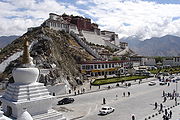
Religion in Tibet
Encyclopedia

Buddhism
Buddhism is a religion and philosophy encompassing a variety of traditions, beliefs and practices, largely based on teachings attributed to Siddhartha Gautama, commonly known as the Buddha . The Buddha lived and taught in the northeastern Indian subcontinent some time between the 6th and 4th...
since its outspread in the 8th century AD. Before the arrival of Buddhism the main religion here was an indigenous Shamanist religion, Bön which now comprises a sizeable minority and which would later influence the formation of Tibetan Buddhism
Tibetan Buddhism
Tibetan Buddhism is the body of Buddhist religious doctrine and institutions characteristic of Tibet and certain regions of the Himalayas, including northern Nepal, Bhutan, and India . It is the state religion of Bhutan...
.
There are four mosques in the Tibet Autonomous Region
Tibet Autonomous Region
The Tibet Autonomous Region , Tibet or Xizang for short, also called the Xizang Autonomous Region is a province-level autonomous region of the People's Republic of China , created in 1965....
with approximately 4,000 to 5,000 Muslim adherents, as well as a Catholic church with 560 parishioners, which is located in the traditionally Catholic community of Yanjing
Yanjing
Yanjing can refer to:* Yanjing the ancient capital of the State of Yan, former name of Beijing* Yanjing Beer* A fictional analog of China in Tamora Pierce's Emelan universe....
in the eastern TAR.
Buddhism
Buddhism came to Tibet from India in the 7th — 8th centuries A.D. and gradually, though not without difficulties, started to prevail in this region. With the influence of the indigenous Bon religion, the Tibetan BuddhismTibetan Buddhism
Tibetan Buddhism is the body of Buddhist religious doctrine and institutions characteristic of Tibet and certain regions of the Himalayas, including northern Nepal, Bhutan, and India . It is the state religion of Bhutan...
was formed.
There were over 6,000 monasteries in Tibet, and nearly all were ransacked and destroyed by the Chinese communists (many of them young ethnic Tibetan Red Guards
Red Guards (China)
Red Guards were a mass movement of civilians, mostly students and other young people in the People's Republic of China , who were mobilized by Mao Zedong in 1966 and 1967, during the Cultural Revolution.-Origins:...
), mainly during the Cultural Revolution
Cultural Revolution
The Great Proletarian Cultural Revolution, commonly known as the Cultural Revolution , was a socio-political movement that took place in the People's Republic of China from 1966 through 1976...
. Most of the major ones have been at least partially re-established but many still remain in ruins.
Bön
Bön, the indigenous animist and shamanistic belief system of Tibet, revolves around the worship of natureNature
Nature, in the broadest sense, is equivalent to the natural world, physical world, or material world. "Nature" refers to the phenomena of the physical world, and also to life in general...
and predates Buddhism. Although Bön was initially the religion to which the Buddhateachings were antithetical, it now has come to be regarded as the fifth of the Tibetan Buddhist traditions.
Christianity

Patriarch
Originally a patriarch was a man who exercised autocratic authority as a pater familias over an extended family. The system of such rule of families by senior males is called patriarchy. This is a Greek word, a compound of πατριά , "lineage, descent", esp...
of the Nestorian
Nestorian
Nestorian or Nestorians can refer to:*Nestorianism, a Christological doctrine developed by Nestorius, Patriarch of Constantinople, condemned as heresy by the Council of Ephesus in 431...
Church
Church
In the Christian religion, a church building is a building or structure whose primary purpose is to facilitate the meeting of a church. Originally, Jewish Christians met in synagogues, such as the Cenacle, and in one another's homes, known as house churches...
, dated as early as the beginning of the 9th century, is the oldest evidence of Christian
Christian
A Christian is a person who adheres to Christianity, an Abrahamic, monotheistic religion based on the life and teachings of Jesus of Nazareth as recorded in the Canonical gospels and the letters of the New Testament...
missionaries in Tibet. Recent historical research indicates the presence of some form of Christianity in as early as the 6th and 7th centuries in Tibet.
The Tibetan Golok people
Golok people
The Golok or Ngolok peoples are groups from Amdo in eastern Tibet, where their territory is referred in Tibetan as sMar-kog. They are located around the upper reaches of the Yellow River and the sacred mountain Amnye Machen . They are not an homogeneous group but are composed of peoples of very...
, owing allegiance to Labrang, attacked the Muslim Ninghai Army
Ninghai Army
The Ninghai Army was a Muslim Hui army in the Republic of China commanded by General Ma Qi, who controlled the Xining area of Qinghai, then a special region of Gansu province. It was founded by Ma Qi in 1915.-Composition and History:...
several times. The Chinese had never been able to control the Goloks before. However, this time, the Muslim Ninghai Army brought their modernized weapons, and exterminated a group of Goloks. The Muslim army then called for negotiations, during which they slaughtered the Goloks, klling "men, women and children", and drowned thousands of them in the Yellow River
Yellow River
The Yellow River or Huang He, formerly known as the Hwang Ho, is the second-longest river in China and the sixth-longest in the world at the estimated length of . Originating in the Bayan Har Mountains in Qinghai Province in western China, it flows through nine provinces of China and empties into...
. After Tibetans attacked the Ninghai muslim army in 1922 and 1923, the Ninghai army returned in 1924 and crushed the Tibetans, killing numerous Tibetans.
The Bible
Bible
The Bible refers to any one of the collections of the primary religious texts of Judaism and Christianity. There is no common version of the Bible, as the individual books , their contents and their order vary among denominations...
was translated into Tibetan script in 1948, but this specific dialect is now understood by very few Tibetans, so new works are in progress. Scripture portions and evangelistic materials ranging from written tracts to the Jesus film and other video and audio CDs are now being distributed.
Islam
There is a small MuslimMuslim
A Muslim, also spelled Moslem, is an adherent of Islam, a monotheistic, Abrahamic religion based on the Quran, which Muslims consider the verbatim word of God as revealed to prophet Muhammad. "Muslim" is the Arabic term for "submitter" .Muslims believe that God is one and incomparable...
population in Bhutan. who are scattered throughout Tibet, much of whom can be found in Lhasa
Lhasa
Lhasa is the administrative capital of the Tibet Autonomous Region in the People's Republic of China and the second most populous city on the Tibetan Plateau, after Xining. At an altitude of , Lhasa is one of the highest cities in the world...
and Shigatse
Shigatse
Shigatse is a county-level city and the second largest city in Tibet Autonomous Region , People's Republic of China, with a population of 92000, about southwest of Lhasa and northwest of Gyantse...
.
Freedom of religion
The religion is freedom is virtually not guaranteed since Tibet is a part of the People's Republic of ChinaPeople's Republic of China
China , officially the People's Republic of China , is the most populous country in the world, with over 1.3 billion citizens. Located in East Asia, the country covers approximately 9.6 million square kilometres...
which restrict the practice of religions. Although in the past there were reports of the deaths of monks and nuns due to maltreatment in prison, there were no known reports of deaths due to maltreatment in prison during the period covered by this report. Buddhist leaders such as Gendun Choekyi Nyima and Tenzin Delek remained in detention or prison.

